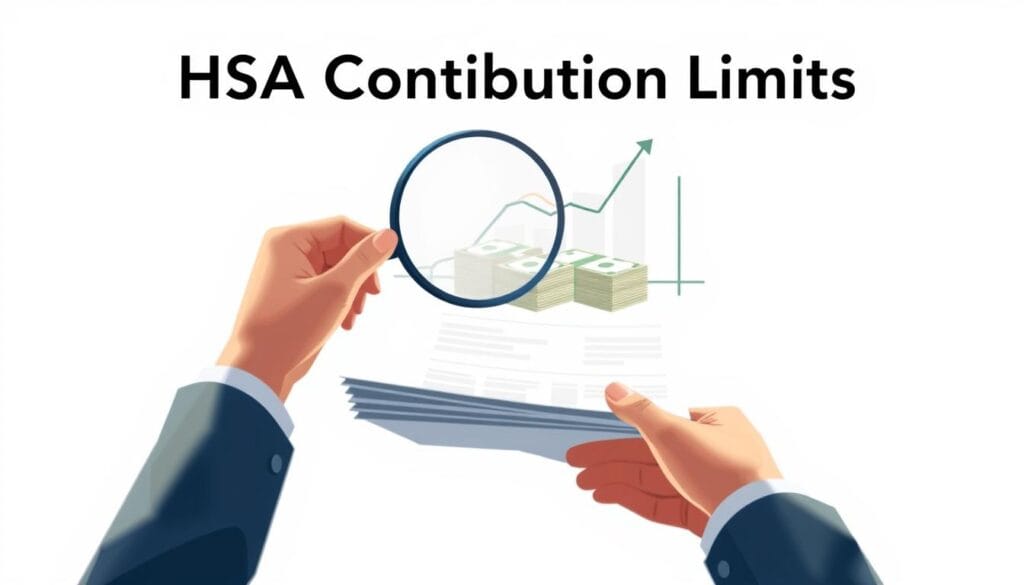Surprising fact: a single 65-year-old may need about $172,500 after-tax for future medical costs, and a couple could face roughly $315,000.
That scale changes how you think about preparing. An HSA can be a powerful vehicle with a triple tax advantage: pre-tax contributions, tax-free growth, and tax-free withdrawals for qualified expenses.
HSAs roll over each year, are portable, and let you invest for long-term growth. After age 65, nonmedical withdrawals are tax‑able but penalty‑free, which adds flexibility.
For 2025, contribution limits are $4,300 for individuals and $8,550 for families; 2026 limits rise slightly. Those 55+ may add a $1,000 catch-up contribution.
Use employer websites and payroll tools to sync contributions and model future costs. For related income topics, see maximizing Social Security.
Key Takeaways
- HSAs offer three tax benefits: pre-tax funding, tax-free growth, and tax-free qualified withdrawals.
- Balances roll over, are portable, and can be invested for long-term growth.
- Know the 2025 and 2026 contribution limits and the $1,000 catch-up for ages 55+.
- HSAs can pay many Medicare premiums and certain long-term care insurance costs.
- After 65, nonmedical withdrawals are taxed but not penalized, adding flexibility.
What a Health Savings Account Is and Why It Matters for Retirement

Think of an HSA as a personal account that grows tax-free and can cover qualified medical expenses now or later.
Triple tax advantage: contributions made through payroll are pre-tax and can avoid Social Security and Medicare taxes. Funds then grow tax-free, and withdrawals for qualified medical expenses are tax-free too. After‑tax contributions outside payroll are deductible on your return, yielding similar benefits.
How HSAs differ from other accounts
Unlike FSAs, HSA balances roll over each year and stay with you if you change jobs. They are individually owned and offer both short-term access and long-term growth.
Eligibility basics
You must be enrolled in an HSA-eligible high-deductible health plan to contribute. If you lose that coverage, you can still use existing funds to pay qualified medical expenses, but you cannot add new contributions until eligible again.
- What counts: deductibles, copays, coinsurance, prescriptions, dental and vision.
- Keep records: save receipts to verify pay qualified claims later.
- Verify: check plan documents or provider information before contributing.
HSAs act as a flexible vehicle across the years. For related employer contribution guidance, see top 401(k) plans.
retirement health savings plan: Key Benefits, Drawbacks, and Fit for Seniors

An HSA can offer focused protection for medical expenses without forcing withdrawals from other accounts.
Core advantages include portability across employers, balances that roll over year to year, and no required minimum distributions. That combination gives retirees and pre-retirees control over timing and taxation.
Pros for retirees and pre-retirees
- Tax-free withdrawals for qualified medical expenses help manage health care costs without tapping taxable income.
- No RMDs means funds can keep compounding for years, preserving tax-advantaged growth.
- Portability allows the account to move with you between jobs or into full retirement.
Common limits and misconceptions that can reduce value
You cannot contribute once you lose HSA-eligible high-deductible coverage or after enrolling in Medicare, though existing balances remain usable for qualified costs.
After age 65, nonqualified withdrawals are taxed as ordinary income but are penalty-free. That makes the account a possible way to supplement income, though it reduces future tax-free medical funding.
| Feature | Benefit | Watch out |
|---|---|---|
| Portability | Account stays with you | Verify investment options at new custodians |
| Rollover | Funds compound across years | Spending today reduces future growth |
| No RMDs | Flexibility in withdrawal timing | Nonqualified withdrawals taxed after 65 |
Practical tips: keep receipts, avoid contributing when not eligible, and compare HSA use with IRAs or 401(k)s. For guidance on balancing accounts, see top IRA accounts for beginners.
Contribution Rules, Limits, and Catch-up Opportunities

Understanding the annual caps and contribution rules helps you make every dollar count in your HSA.
Annual limits: For 2024 the IRS caps were $4,150 (individual) and $8,300 (family). For 2025 the limits rise to $4,300 and $8,550, and 2026 moves to $4,400 and $8,750. Employer contributions count toward these totals.
Employer dollars and timing
Employer deposits reduce how much you may add. In 2023 employers averaged about $726, which can cut your out‑of‑pocket need.
Catch-up contributions at 55+
If you are age 55 or older you may add a $1,000 catch-up each year. A spouse can add another $1,000 only if they maintain their own HSA account.
Payroll vs. after-tax funding
Payroll deductions are pre-tax and usually avoid FICA, simplifying contributions. After-tax deposits to an outside HSA are deductible on your return but do not dodge payroll taxes when funded.
- Confirm eligibility: you must be covered by an HSA-eligible high-deductible health plan to contribute; stop contributions once you enroll in Medicare.
- Track combined family caps if you and your spouse hold separate accounts to avoid excess contributions.
For related tax guidance, see top tax deduction strategies.
Spending vs. Saving: Strategies to Maximize Long-Term Value

Paying some costs now while investing the rest of your HSA balance can increase long‑term tax‑free purchasing power.
When to pay out of pocket: If you can cover current medical expenses from other cash or liquid accounts, consider paying now and leaving HSA dollars invested. That lets the account compound and may boost what you have for later years.
Save receipts: Keep detailed receipts and explanations of benefits for any qualified care incurred after you opened the HSA. You can reimburse yourself years later as long as documentation proves the date and that expenses meet IRS rules.
- Prioritize a long‑term strategy: pay small, nonurgent bills out of pocket to preserve HSA growth.
- Keep a modest cash buffer inside the account for near‑term surprises and invest the remainder.
- Document every qualified expense carefully so you can pay qualified reimbursements later without audit risk.
- Consult a tax professional about documentation and timing to protect tax benefits and avoid mistakes.
Revisit your approach each year. Adjust for changing expenses, market returns, and personal timelines to balance liquidity and compound growth.
Investing HSA Funds for Retirement

Start with a clear split: set aside liquid cash, then let the rest grow through investments.
Set a cash cushion. Keep enough inside the account to cover expected deductibles and short-term expenses. Many HSA providers require a minimum cash balance before allowing investing, so confirm that threshold first.
Choose investments that match your broader portfolio. Use low-cost index funds, a mix of equities and bonds based on your time horizon, and automatic features to funnel contributions above the cash cushion into the market.
| Action | Why it matters | How to implement |
|---|---|---|
| Maintain cash cushion | Protects liquidity for near-term costs | Hold an amount equal to deductible or out-of-pocket portion |
| Diversify investments | Balances growth and risk | Use index funds and rebalance yearly |
| Watch fees | Preserves compounding | Compare expense ratios and provider charges |
| Use tax advantage | HSA withdrawals for qualified expenses are tax-free | Reserve HSA for medical costs; compare after-tax outcomes to IRAs/401(k)s |
Simple math to guide choices: $1,000 at 7% for 30 years becomes about $7,612. If taxed at an effective 22% from a traditional IRA, the after-tax sum falls closer to $5,937. That gap shows how tax treatment can boost net outcomes when funds pay qualified medical expenses.
For details on complementary retirement accounts and provider choices, see top Roth IRA providers.
Using Your HSA in Retirement: Medicare, Premiums, and Nonmedical Withdrawals
When you stop working or enroll in Medicare, your HSA can still pay many qualified costs and premiums. That makes the account a flexible tool for later-life health care spending.
What qualified medical expenses include in later life
Qualified medical expenses still cover deductibles, copays, coinsurance and prescriptions. Dental, vision, and many other qualified medical services remain eligible and can be paid tax-free from the account.
Paying Medicare Part B, Part D, and Medicare Advantage premiums
You may pay qualified Medicare Part B, Part D, and Medicare Advantage premiums with HSA funds. Important: Medigap (Medicare Supplement) premiums are not eligible. COBRA and premiums while on unemployment are allowed in special cases, too.
Rules after age 65: nonqualified withdrawals
After age 65, nonqualified withdrawals become taxable as ordinary income but no longer face the 20% penalty. That gives you a backup source of dollars if needed, though it reduces funds reserved for future medical costs.
Long-term care insurance and other later-life costs
HSA dollars may also cover tax-qualified long-term care insurance premiums up to age-based limits. Keep statements and receipts to substantiate distributions and protect the tax treatment of withdrawals.
“Coordinate HSA distributions with your broader income to manage taxable income and Medicare thresholds.”
- Document every expense to prove it was a qualified medical expense.
- Use hsa funds strategically in high-expense years to protect other tax-deferred assets.
- Review coverage and costs each Medicare open enrollment to align withdrawals with current benefits.
Planning Tools, Employer Support, and Cost Estimates to Guide Your Strategy
https://www.youtube.com/watch?v=rQG_z2MizJU
Use employer tools to run a forward-looking estimate that compares lifetime medical costs to projected HSA balances. This reveals gaps early and helps set achievable contribution targets. Small adjustments now can compound into meaningful coverage later.
Projected costs and closing gaps
Project lifetime costs by modeling premiums, prescriptions, and expected out-of-pocket expenses. Tools from providers like Empower Retirement can blend prior-year contributions and forecasted returns. That gives a side-by-side view of projected HSA and retirement plan balances.
Compare those projections to identify shortfalls. Then set a contribution target and a timeline to close the gap without disrupting other priorities.
Employer platforms and payroll integration
Leverage employer websites that link contribution edits directly to payroll. Automated deferrals improve consistency and make it simple to increase funding when limits change.
- Use cost estimates to set goals and compare expected account balances.
- Choose platforms that show how savings accounts allocate to expense categories.
- Automate contributions via payroll to keep funding steady and easy to adjust.
- Seek education modules if you or colleagues find HSAs confusing; users who engage report higher confidence covering future expenses.
| Feature | Benefit | Action |
|---|---|---|
| Cost projection tools | Clear gap analysis | Run annual scenarios and update assumptions |
| Payroll integration | Automatic contributions | Set deferrals and enable quick changes |
| Employer contributions view | Full savings picture | Factor employer dollars into targets |
| Provider fees & menus | Impact on long-term balance | Compare providers and switch if fees erode growth |
Takeaways: use employer tools and payroll links to translate models into action. Review projections yearly, adjust investments and contributions, and record action items before open enrollment.
For further guidance on integrating AI tools into your broader retirement strategy, see plan your retirement with AI-powered financial.
Conclusion
A focused HSA strategy can turn modest contributions into a meaningful buffer for future medical costs.
Use the account’s triple tax edge—pre-tax funding, tax-free growth, and tax-free withdrawals for qualified medical expenses—to lower overall taxable income and stretch dollars over many years.
Keep annual limits and the $1,000 catch-up in your calendar, invest funds beyond a cash cushion, and document every qualified expense. Coordinate HSA choices with your other retirement accounts and consult an advisor when rules or life events change.
For context on payout choices that affect income in later years, see this short guide on annuity vs lump sum.

